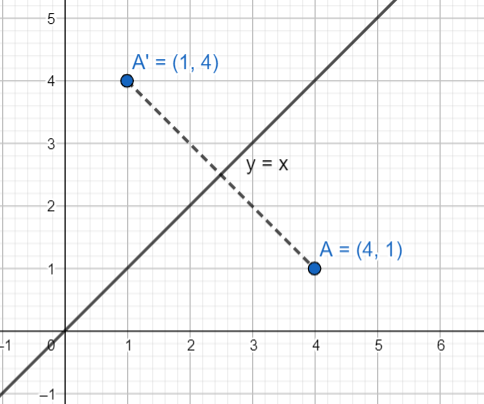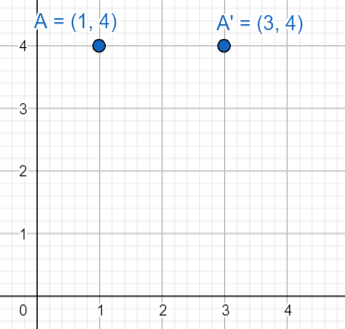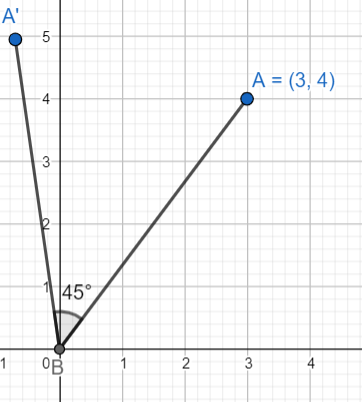
Answer
430.2k+ views
Hint: We will find the image of the given point after reflection about the line \[y = x\]. We will then find the coordinates of the point after the translation of the image along the \[x\] axis. We will use the formula for the rotation of a point about the origin to find the final position of the point.
Complete step-by-step answer:
If any point (say \[\left( {a,b} \right)\]) is reflected about the line \[y = x\], then its image is the point \[\left( {b,a} \right)\]; that is the abscissa and the ordinate get interchanged.
So, the reflection of the point \[\left( {4,1} \right)\] about the line \[x = y\] will be the point \[\left( {1,4} \right)\].

Now, the point is translated through a distance of 2 units along the positive direction of the\[x\] axis.
So, the new point’s abscissa or the \[x\] coordinate will be 2 units more than the older abscissa. We will find the new point:
\[ \Rightarrow \left( {1 + 2,4} \right) = \left( {3,4} \right)\]

The new point will be \[\left( {3,4} \right)\].
Now, the point is rotated through an angle \[\dfrac{\pi }{4}\] about the origin in the anti-clockwise sense.

We will substitute \[45^\circ \] for \[\theta \], 3 for \[a\] and 4 for \[b\] in the formula for rotation of a point, \[\left( {a\cos \theta - b\sin \theta ,a\cos \theta + b\sin \theta } \right)\]. Therefore we get
\[\left( {a\cos \theta - b\sin \theta ,a\cos \theta + b\sin \theta } \right) = \left( {3\cos 45^\circ - 4\sin 45^\circ ,3\cos 45^\circ + 4\sin 45^\circ } \right)\]
Substituting the values of all trigonometric function, we get
\[\begin{array}{l} \Rightarrow \left( {3\cos 45^\circ - 4\sin 45^\circ ,3\cos 45^\circ + 4\sin 45^\circ } \right) = \left( {\dfrac{3}{{\sqrt 2 }} - \dfrac{4}{{\sqrt 2 }},\dfrac{3}{{\sqrt 2 }} + \dfrac{4}{{\sqrt 2 }}} \right)\\ \Rightarrow \left( {3\cos 45^\circ - 4\sin 45^\circ ,3\cos 45^\circ + 4\sin 45^\circ } \right) = \left( { - \dfrac{1}{{\sqrt 2 }},\dfrac{7}{{\sqrt 2 }}} \right)\end{array}\]
$\therefore $ The final position of the point is \[\left( { - \dfrac{1}{{\sqrt 2 }},\dfrac{7}{{\sqrt 2 }}} \right)\].
Option C is the correct option.
Note: If we get a case where the a point is rotated by an angle of \[\theta \] about the origin in the clockwise direction, we will substitute \[ - \theta \] in the formula instead of \[\theta \]. We can derive this formula using vector calculus and the Pythagoras theorem.
When a point (say \[\left( {a,b} \right)\]) is rotated by an angle \[\theta \] about the origin, then the coordinates of the new point are \[\left( {a\cos \theta - b\sin \theta ,a\cos \theta + b\sin \theta } \right)\].
Complete step-by-step answer:
If any point (say \[\left( {a,b} \right)\]) is reflected about the line \[y = x\], then its image is the point \[\left( {b,a} \right)\]; that is the abscissa and the ordinate get interchanged.
So, the reflection of the point \[\left( {4,1} \right)\] about the line \[x = y\] will be the point \[\left( {1,4} \right)\].

Now, the point is translated through a distance of 2 units along the positive direction of the\[x\] axis.
So, the new point’s abscissa or the \[x\] coordinate will be 2 units more than the older abscissa. We will find the new point:
\[ \Rightarrow \left( {1 + 2,4} \right) = \left( {3,4} \right)\]

The new point will be \[\left( {3,4} \right)\].
Now, the point is rotated through an angle \[\dfrac{\pi }{4}\] about the origin in the anti-clockwise sense.

We will substitute \[45^\circ \] for \[\theta \], 3 for \[a\] and 4 for \[b\] in the formula for rotation of a point, \[\left( {a\cos \theta - b\sin \theta ,a\cos \theta + b\sin \theta } \right)\]. Therefore we get
\[\left( {a\cos \theta - b\sin \theta ,a\cos \theta + b\sin \theta } \right) = \left( {3\cos 45^\circ - 4\sin 45^\circ ,3\cos 45^\circ + 4\sin 45^\circ } \right)\]
Substituting the values of all trigonometric function, we get
\[\begin{array}{l} \Rightarrow \left( {3\cos 45^\circ - 4\sin 45^\circ ,3\cos 45^\circ + 4\sin 45^\circ } \right) = \left( {\dfrac{3}{{\sqrt 2 }} - \dfrac{4}{{\sqrt 2 }},\dfrac{3}{{\sqrt 2 }} + \dfrac{4}{{\sqrt 2 }}} \right)\\ \Rightarrow \left( {3\cos 45^\circ - 4\sin 45^\circ ,3\cos 45^\circ + 4\sin 45^\circ } \right) = \left( { - \dfrac{1}{{\sqrt 2 }},\dfrac{7}{{\sqrt 2 }}} \right)\end{array}\]
$\therefore $ The final position of the point is \[\left( { - \dfrac{1}{{\sqrt 2 }},\dfrac{7}{{\sqrt 2 }}} \right)\].
Option C is the correct option.
Note: If we get a case where the a point is rotated by an angle of \[\theta \] about the origin in the clockwise direction, we will substitute \[ - \theta \] in the formula instead of \[\theta \]. We can derive this formula using vector calculus and the Pythagoras theorem.
When a point (say \[\left( {a,b} \right)\]) is rotated by an angle \[\theta \] about the origin, then the coordinates of the new point are \[\left( {a\cos \theta - b\sin \theta ,a\cos \theta + b\sin \theta } \right)\].
Recently Updated Pages
Who among the following was the religious guru of class 7 social science CBSE

what is the correct chronological order of the following class 10 social science CBSE

Which of the following was not the actual cause for class 10 social science CBSE

Which of the following statements is not correct A class 10 social science CBSE

Which of the following leaders was not present in the class 10 social science CBSE

Garampani Sanctuary is located at A Diphu Assam B Gangtok class 10 social science CBSE

Trending doubts
A rainbow has circular shape because A The earth is class 11 physics CBSE

Which are the Top 10 Largest Countries of the World?

Fill the blanks with the suitable prepositions 1 The class 9 english CBSE

Which of the following was the capital of the Surasena class 6 social science CBSE

How do you graph the function fx 4x class 9 maths CBSE

The Equation xxx + 2 is Satisfied when x is Equal to Class 10 Maths

Give 10 examples for herbs , shrubs , climbers , creepers

Difference between Prokaryotic cell and Eukaryotic class 11 biology CBSE

Who was the first Director General of the Archaeological class 10 social science CBSE




